Story length in journalism by itself doesn’t mean much. We read too many news stories that are just too damned long.
But, on the other hand, without going long, it’s hard to achieve greatness. It sure makes harder to tell a story or lay out evidence, much less capture nuance and complexity. A longer story signals to readers that this story is important and that more work went into it.
This is to say that your average 4,000 word piece is just going to be reported more deeply and edited more heavily than your average 400-word FT news story, say. It’s possible there’s a great business journalism haiku poet out there, I suppose. Let us know if you spot one.
The Wall Street Journal‘s page one has long been the standard-bearer for business writing and reporting, at least for newspapers. It took news and turned it into narrative nonfiction, everyday, twice a day, for decades. But Rupert Murdoch made it no secret that he disdained the Journal‘s page-one tradition of long-form journalism, and it’s been de-emphasized under his ownership. That’s our qualitative impression, anyway, based on reading the paper, following the tealeaves, and talking to former colleagues.
I wondered if you could quantify it, though, so I turned to Journal corporate cousin Factiva to put together these charts showing the drop-off in long-form reporting on page one of the paper.
Here’s the number of A1 stories longer than 1,500 words in the last decade (note that I annualized all the 2011 numbers in this post since we’ve still got eleven-plus weeks left this year):
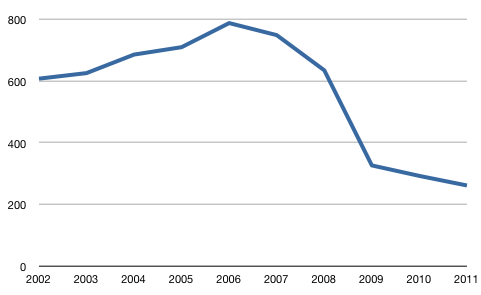
Murdoch took over at the end of 2007, defenestrated Marcus Brauchli four months later, and these stories have plunged a stunning 70 percent in the Murdoch era.
Naturally, shorter stories have replaced them. Here’s a chart of under-1,500-word stories on page one going back a decade (not including the What’s News columns):
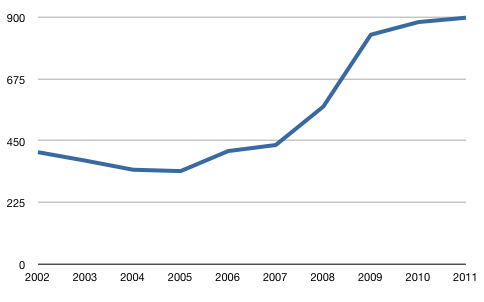
Shorter stories have doubled under Murdoch and Thomson. It’s worth noting that almost all of the short stories in the pre-Murdoch years seen on these charts were aheds. If you removed aheds, this jump would be much more dramatic.
Really long stories—the special ones given lots of space—basically don’t exist under Murdoch. Here’s a chart of 2,500-plus word stories on page one:
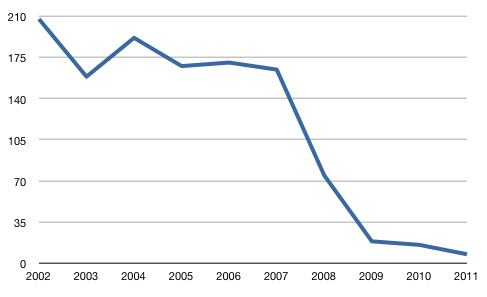
That’s a roughly 95 percent drop.
It’s not just page one, either. Here’s the number of 1,500-word stories throughout the paper:
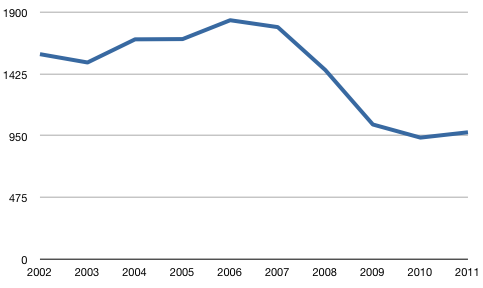
Even thousand-word stories are down significantly:
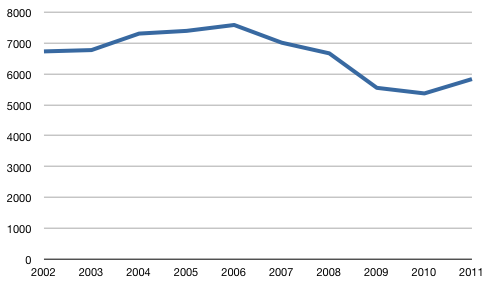
This isn’t because total stories have been decreasing. Story counts in the paper have been steadily going up, even before Murdoch took over, as Audit Head Veterinarian Dean Starkman wrote last year in “Hamster Wheel“—and that’s not including things like blog posts, video hits, and early news stories for WSJ.com or “speedys” for Dow Jones Newswires.
Certainly, the Journal still does lots of top-flight work, and most stories don’t need 2,500 words. But many do, and how does going short as a policy help readers understand the really important stuff like systemic problems, corporate misbehavior, business innovation, or sweeping economic change?
UPDATE:
Felix Salmon responds here in favor of Murdoch’s move toward shorter stories.
I’d suggest that what he misses in saying that readers “want their news-delivery mechanism to be as efficient as possible” is that these old WSJ stories, for the most part, weren’t news stories at all—at least in the traditional sense of “this happened yesterday so we’re reporting it today.”
Most of the time they weren’t something you had to read. They were something you wanted to read. Somwhere between a long newspaper story and a magazine piece, and now they have been diluted or have disappeared.
Ryan Chittum is a former Wall Street Journal reporter, and deputy editor of The Audit, CJR’s business section. If you see notable business journalism, give him a heads-up at rc2538@columbia.edu. Follow him on Twitter at @ryanchittum.
